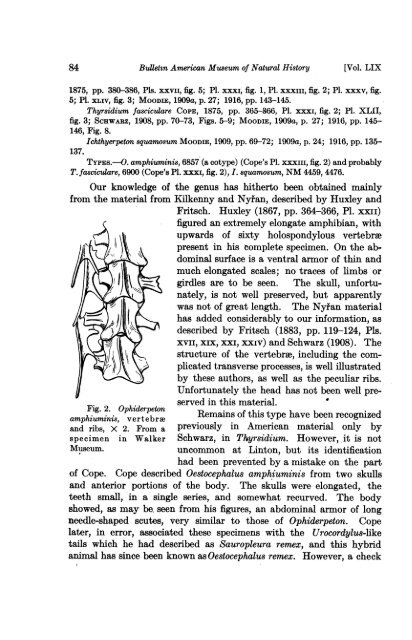View/Open - American Museum of Natural History
View/Open - American Museum of Natural History
View/Open - American Museum of Natural History
You also want an ePaper? Increase the reach of your titles
YUMPU automatically turns print PDFs into web optimized ePapers that Google loves.
84A<br />
Bulletin <strong>American</strong> <strong>Museum</strong> <strong>of</strong> <strong>Natural</strong> <strong>History</strong><br />
[Vol. LIX<br />
1875, pp. 380-386, Pis. XXVII, fig. 5; P1. xxxi, fig. 1, P1. xxxiii, fig. 2; P1. xxxv, fig.<br />
5; P1. XLIV, fig. 3; MOODIE, 1909a, p. 27; 1916, pp. 143-145.<br />
Thyrsidium fasciculare COPE, 1875, pp. 365-866, P1. xxxi, fig. 2; P1. XLII,<br />
fig. 3; SCHWARZ, 1908, pp. 70-73, Figs. 5-9; MOODIE, 1909a, p. 27; 1916, pp. 145-<br />
146, Fig. 8.<br />
Ichthyerpeton squamosum MOODIE, 1909, pp. 69-72; 1909a, p. 24; 1916, pp. 135-<br />
137.<br />
TYPES.-O. amphiuminis, 6857 (a cotype) (Cope's P1. xxxIII, fig. 2) and probably<br />
T. fasciculare, 6900 (Cope's P1. xxxi, fig. 2), I. 8squamosum, NM 4459, 4476.<br />
Our knowledge <strong>of</strong> the genus has hitherto been obtained mainly<br />
from the material from Kilkenny and NyMan, described by Huxley and<br />
Fritsch. Huxley (1867, pp. 364-366, P1. Ii)<br />
figured an extremely elongate amphibian, with<br />
upwards <strong>of</strong> sixty holospondylous vertebrae<br />
present in his tomplete specimen. On the abdominal<br />
surface is a ventral armor <strong>of</strong> thin and<br />
much elongated scales; no traces <strong>of</strong> limbs or<br />
i+G)\l\ /1 : girdles are to be seen. The skull, unfortu-<br />
( /S unately, is not well preserved, but apparently<br />
was not <strong>of</strong> great length. The Nyfan material<br />
has added considerably to our information, as<br />
(K<br />
.'W27 described by Fritsch (1883, pp. 119-124, Pls.<br />
XVII, xix, xxi, xxiv) and Schwarz (1908). The<br />
structure <strong>of</strong> the vertebraw, including the complicated<br />
transverse processes, is well illustrated<br />
by these authors, as well as the peculiar ribs.<br />
Unfortunately the head has not been well preserved<br />
in this material.<br />
Fig. 2. Ophiderpeton<br />
amphiuminis, vertebra Remais <strong>of</strong> this type have been recognized<br />
and ribs, X 2. From a previously in <strong>American</strong> material only by<br />
specimen in Walker Schwarz, in Thyrsidium. However, it is not<br />
<strong>Museum</strong>. uncommon at Linton, but its identification<br />
had been prevented by a mistake on the part<br />
<strong>of</strong> Cope. Cope described Oestocephalus amphiuminis from two skulls<br />
and anterior portions <strong>of</strong> the body. The skulls were elongated, the<br />
teeth small, in a single series, and somewhat recurved. The body<br />
showed, as may be seen from his figures, an abdominal armor <strong>of</strong> long<br />
needle-shaped scutes, very similar to those <strong>of</strong> Ophiderpeton. Cope<br />
later, in error, associated these specimens with the Urocordylus-like<br />
tails which he had described as Sauropleura remex, and this hybrid<br />
animal has since been known as Oestocephalus remex. However, a check
















